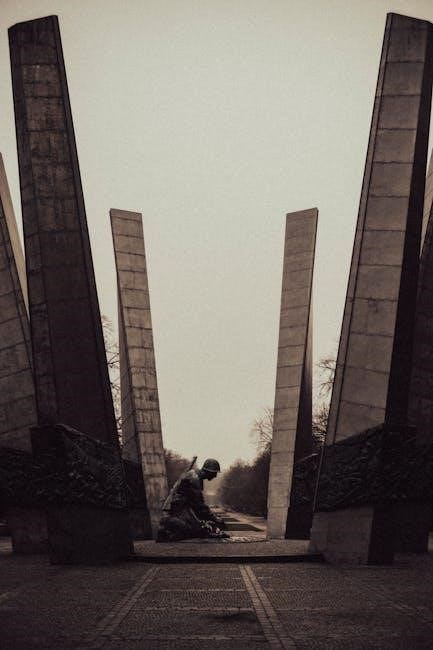The War Scroll, a significant Dead Sea Scroll, outlines an apocalyptic battle between the Sons of Light and Sons of Darkness, detailing military strategy and divine intervention.
1.1 Discovery and Significance
The War Scroll, discovered in Qumran Cave 1 in 1947, is one of the seven original Dead Sea Scrolls. It is a well-preserved manuscript detailing an apocalyptic war between the Sons of Light and Sons of Darkness. Its discovery has significantly enhanced understanding of ancient Jewish eschatology, military organization, and theological beliefs, making it a cornerstone of Qumran studies.
1.2 Overview of the Document
The War Scroll outlines a 40-year war program, detailing military tactics, trumpets, standards, and formations. It emphasizes divine intervention, with priests and Levites playing central roles. The document also includes liturgical prayers and thanksgiving songs, reflecting a blend of military strategy and religious devotion, structured into columns that guide the Sons of Light to ultimate victory over darkness.
Historical Background
The War Scroll is part of the Dead Sea Scrolls, discovered in Qumran Cave 1 in 1947. It reflects the theological and military ideals of the Qumran community, likely authored by the Essenes, offering insights into their apocalyptic views and communal practices during the Second Temple period.
2.1 The Dead Sea Scrolls and Qumran
The Dead Sea Scrolls, including the War Scroll, were discovered in Qumran near the Dead Sea in 1947. These texts, hidden in caves, provide insights into Jewish thought and practices during the Second Temple period. Qumran, believed to be the settlement of the Essenes, is central to understanding the Scrolls’ origins and significance in ancient Jewish history and religion.
2.2 The War Scroll in Context
The War Scroll is part of the Dead Sea Scrolls found in Qumran Cave 1. It serves as a manual for military organization and strategy, outlining an apocalyptic battle between the Sons of Light and the Sons of Darkness. The text includes detailed descriptions of trumpets, standards, and war formations, as well as the role of priests and Levites, reflecting a blend of military and liturgical practices rooted in Jewish apocalyptic theology.
2.3 Authorship and Date
The War Scroll is believed to have been authored by the Qumran community, likely between 150 BCE and 30 BCE. Its discovery in Qumran Cave 1 in 1947 placed it among the Dead Sea Scrolls, offering insights into Jewish apocalyptic thought and military practices of the Second Temple period.

The Eschatological War
The War Scroll describes an apocalyptic conflict between the Sons of Light and Sons of Darkness, envisioning a divine victory over evil, fulfilling God’s plan for redemption.
3.1 The Sons of Light vs. the Sons of Darkness
The War Scroll depicts the Sons of Light, led by God, in a final battle against the Sons of Darkness, representing evil forces; The conflict involves enemies like Edom, Moab, and Philistia, with Belial leading the darkness. The text emphasizes divine support for the Sons of Light, ensuring their ultimate victory and the triumph of righteousness over evil.
3.2 The Final Battle and Its Significance
The final battle in the War Scroll symbolizes the ultimate triumph of good over evil, with the Sons of Light, aided by divine intervention, defeating the Sons of Darkness. This eschatological conflict restores righteousness, purifying the world and fulfilling God’s plan. The battle’s significance lies in its theological message of hope and redemption through divine victory.
Military Organization and Strategy
The War Scroll outlines a 40-year war program, detailing military tactics, trumpets, standards, and formations. It emphasizes strategic planning and divine guidance for the Sons of Light.
4.1 The 40-Year War Program
The War Scroll describes a structured 40-year war plan, dividing the conflict into phases. The Sons of Light initially target Edom, Moab, and Ammon, before confronting the Kittim of Asshur. Divine intervention is central, ensuring victory over darkness. Priests and Levites play key roles, with prayers and liturgical support integral to the war effort, blending military strategy with theological devotion.
4.2 Trumpets, Standards, and War Formations
The War Scroll details the use of trumpets for signaling attacks and troop movements, while standards identify military divisions. Specific war formations emphasize discipline and organization, ensuring the Sons of Light’s strategic advantage. These elements highlight the blend of military precision and ritualistic preparation, central to the scroll’s vision of divine victory over the forces of darkness.
Theological Themes
The War Scroll emphasizes divine intervention, portraying God as actively aiding the Sons of Light. It explores themes of predestination, righteousness, and the ultimate triumph of good over evil.
5.1 Divine Intervention in Battle
The War Scroll emphasizes divine intervention as central to the Sons of Light’s victory. God is depicted as actively aiding the righteous, with priests invoking His power to ensure triumph. This theological theme underscores the belief in God’s direct involvement in battle, guaranteeing the ultimate defeat of the Sons of Darkness and the triumph of righteousness.
5.2 The Role of Priests and Levites
Priests and Levites play a crucial role in the War Scroll, leading liturgical and organizational duties. They oversee battle rituals, sound trumpets, and organize formations, ensuring divine support. Their leadership ensures the army’s spiritual purity and alignment with God’s will, emphasizing their importance in both military and religious contexts.

The War Scroll and Biblical Connections
The War Scroll draws parallels with biblical themes of divine warfare and messianic expectations, reflecting apocalyptic visions similar to those in Daniel and Ezekiel, emphasizing God’s role in battle.
6.1 Parallels with Biblical Texts
The War Scroll shares thematic and linguistic parallels with biblical apocalyptic literature, such as Daniel and Ezekiel, depicting a final battle between good and evil. It mirrors biblical imagery of divine warfare, messianic figures, and the ultimate triumph of righteousness. The scroll’s use of trumpets, standards, and sacred rituals also aligns with biblical military practices, reinforcing its theological connections to Jewish scripture and prophecy.
6.2 Theological Similarities and Differences
The War Scroll reflects biblical eschatology, emphasizing divine intervention and a final battle between good and evil. It shares themes of righteousness triumphing over wickedness, akin to Daniel and Ezekiel. However, its detailed military strategies and priestly roles diverge from biblical accounts, offering a unique apocalyptic vision that blends theological tradition with communal specifics, highlighting a dualistic worldview distinct yet rooted in Jewish scripture.

Preservation and Accessibility
The War Scroll is well-preserved, with digital reproductions and translations widely available online, ensuring its contents remain accessible for scholarly and public exploration of its historical significance.
7.1 The Manuscript’s Condition
The War Scroll is one of the best-preserved Dead Sea Scrolls, with 19 columns largely intact. Discovered in Qumran Cave 1, it has survived for centuries, offering valuable insights into ancient military and theological thought. Its condition allows scholars to study its detailed battle plans and religious themes, while digital reproductions further enhance its accessibility for modern research and public interest.
7.2 Digital Reproductions and Translations
Digital reproductions of the War Scroll are widely available, including online platforms like the Israel Museum’s Digital Dead Sea Scrolls. These resources offer high-resolution images and translations, enabling scholars and the public to explore the text’s military strategies and theological themes. PDF versions and downloadable files further facilitate study, making this ancient manuscript accessible to a global audience for research and education.
Cultural and Academic Impact
The War Scroll has significantly influenced academic and cultural discourse, offering insights into ancient Jewish militaristic and theological thought, while sparking scholarly debates and public fascination with its apocalyptic themes.
8.1 Scholarly Significance
The War Scroll is a cornerstone of Dead Sea Scrolls research, offering unparalleled insights into ancient Jewish apocalyptic thought, military strategy, and theological concepts. Its detailed battle plans and divine intervention narratives have fueled extensive academic analysis, making it a pivotal text for understanding Second Temple Judaism and its eschatological visions.
8.2 Popular Interest and Media
The War Scroll captivates public imagination through its vivid depiction of an apocalyptic battle, inspiring numerous books, documentaries, and digital resources. Its availability in PDF formats and online translations has broadened accessibility, making it a focal point of interest for both scholars and enthusiasts exploring ancient Jewish history and eschatology.

The War Scroll in Modern Scholarship
Modern scholarship leverages digital reproductions and translations to study the War Scroll, enhancing understanding of its historical and theological significance through interdisciplinary approaches and ongoing research.
9.1 Key Interpretations and Debates
Scholars debate whether the War Scroll reflects real military strategies or symbolic apocalyptic visions. Its detailed battle plans and divine intervention themes spark discussions on its historical context and theological purpose. Digital reproductions have enhanced analysis, revealing new insights into its structure and significance within Jewish apocalyptic literature and Qumran community beliefs.
9.2 Comparisons with Other Qumran Texts
The War Scroll shares themes with other Qumran texts like the Damascus Document and the Book of War, emphasizing eschatological battles and divine intervention. However, its detailed military strategies and liturgical elements are unique. Scholars compare its apocalyptic visions to other scrolls, noting similarities in theological themes but distinct focuses on the final battle’s organization and spiritual dimensions.
The War Scroll and Jewish Mysticism
The War Scroll reflects Jewish mystical themes, envisioning an apocalyptic battle guided by divine will, with parallels in Jewish apocalyptic literature and eschatological traditions.
10;1 Mystical Elements in the Text
The War Scroll contains mystical elements, such as divine intervention and predestination, portraying an apocalyptic battle between light and darkness. It reflects cosmic dualism, emphasizing God’s role in the final conflict, with the Sons of Light destined to triumph. These themes align with Jewish mystical traditions, blending eschatology and spiritual warfare.
10.2 Connections to Jewish Apocalyptic Literature
The War Scroll shares themes with Jewish apocalyptic literature, such as the expectation of a final eschatological battle and divine intervention. Its depiction of cosmic dualism aligns with texts like Daniel and Enoch, emphasizing the triumph of righteousness over evil. The scroll’s vision of a divinely orchestrated conflict reflects broader Jewish apocalyptic traditions.
These connections highlight the War Scroll’s role in shaping Jewish eschatological thought, blending military strategy with spiritual warfare to illustrate God’s ultimate sovereignty.
The War Scroll and Christian Theology
The War Scroll’s themes of divine intervention and eschatological conflict resonate with Christian theology, particularly in its depiction of spiritual warfare and ultimate triumph of righteousness.
11.1 Parallels with Early Christian Thought
The War Scroll’s depiction of an eschatological conflict mirrors early Christian views of spiritual warfare. Both traditions emphasize divine intervention, the triumph of righteousness, and a final judgment. The Scroll’s concept of a predestined battle aligns with Christian notions of cosmic struggle, while its liturgical prayers and communal preparation echo Christian practices. These parallels highlight shared theological themes across ancient Jewish and Christian texts.
11.2 Theological Influences and Differences
While the War Scroll shares motifs like divine intervention and eschatological battles with Christian theology, it differs in focusing on a communal, ritualistic war rather than individual salvation. The Scroll emphasizes strict adherence to Jewish law and ritual purity, contrasting with Christianity’s universal message. These differences reflect distinct theological paths, yet both traditions draw on similar apocalyptic imagery and messianic expectations.
The War Scroll offers profound insights into ancient Jewish apocalyptic thought, blending military strategy with theology, leaving a lasting legacy in religious and scholarly discourse.
12.1 Summary of Key Points
The War Scroll, a key manuscript among the Dead Sea Scrolls, outlines the apocalyptic conflict between the Sons of Light and Sons of Darkness. It details military strategies, divine intervention, and the role of priests and Levites, offering insights into ancient Jewish theology and eschatology. This text remains a significant resource for understanding Second Temple Period thought and its cultural impact.
12.2 The Enduring Legacy of the War Scroll
The War Scroll remains a vital artifact, offering insights into ancient Jewish theology and eschatology. Its well-preserved state and multiple copies underscore its significance. As a key text among the Dead Sea Scrolls, it continues to influence scholarly debates and popular interest, providing a unique window into the beliefs and practices of the Qumran community, ensuring its relevance for future generations of researchers and enthusiasts alike.
